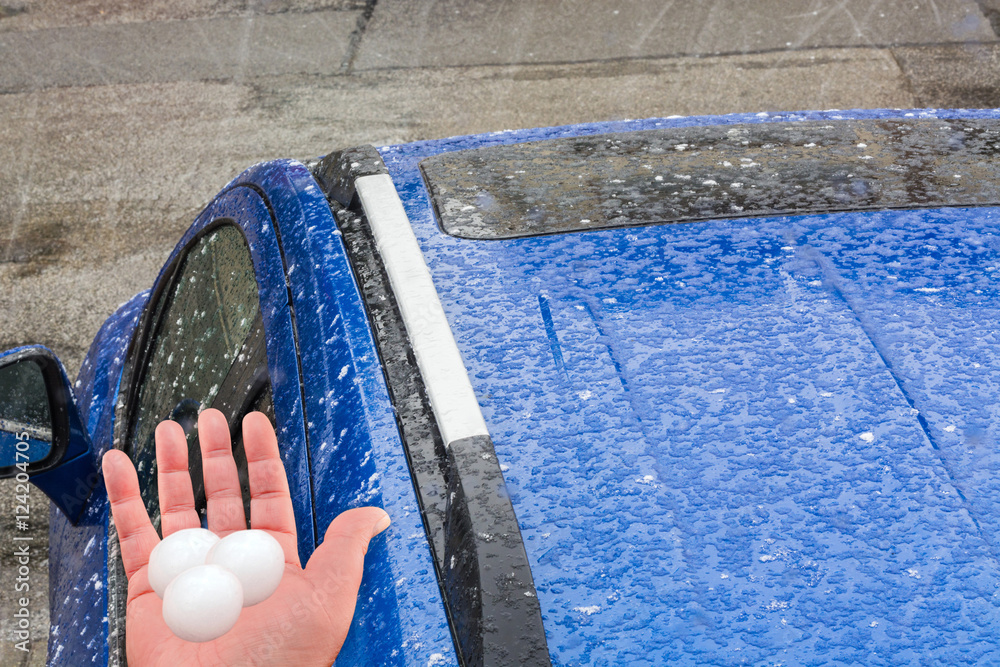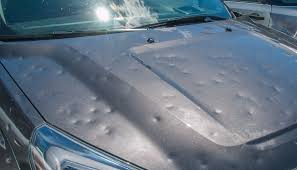Average Insurance Payout for Hail Damage on Car varies based on the severity of damage, insurance coverage, and deductible. Hailstorms can cause dents, cracked windows, and other costly repairs. Understanding the claims process helps you estimate potential payouts and decide whether to file a claim.

What Is Hail Damage?
Hail damage occurs when ice pellets fall from the sky during a thunderstorm. These pellets can vary in size from small peas to large golf balls or even baseballs. Hail damage can affect various parts of your car, from minor dents in the body to shattered windshields and broken side mirrors. In severe cases, the damage may require extensive repairs or even lead to a total loss of the vehicle.

Common Signs of Hail Damage
- Dents on the Roof and Hood: These are the most common areas to sustain hail damage. Depending on the size and force of the hail, you may notice small to medium-sized dings.
- Cracked or Shattered Windows: Larger hailstones can break your windows, which might need replacement.
- Paint Scratches and Chips: Hail can cause paint to chip off, especially if it’s combined with strong winds.
Does Car Insurance Cover Hail Damage?
If your car sustains hail damage, the next question is whether your insurance will cover the costs of repair. In most cases, hail damage is covered by comprehensive auto insurance. However, if you only have liability insurance, hail damage will not be covered. Comprehensive insurance is designed to cover damage from natural events like hail, floods, and vandalism.
How Does Comprehensive Insurance Work?
Comprehensive insurance is typically an optional add-on to your policy. It covers a range of non-collision damages, including theft, vandalism, fire, and weather-related incidents such as hailstorms. If you have comprehensive coverage, hail damage should be covered, minus your deductible.
What Is the Average Insurance Payout for Hail Damage?
The average payout for hail damage can vary greatly depending on a few key factors, such as the severity of the damage, the value of your vehicle, and your insurance policy.
Average Payout Based on Vehicle Value
The value of your car will largely determine the insurance payout. For example, if you have an older vehicle that is worth less, your payout may be on the lower end, potentially just enough to repair the visible damage. Conversely, a newer, more expensive car could receive a higher payout, especially if the damage is extensive.
Average Payout Based on Severity of Damage
Minor hail damage (small dents) could result in a payout of a few hundred dollars, while more severe damage, such as broken windows or large dents across the roof and hood, could see payouts of $2,000 or more. The more damage your car has sustained, the higher the payout you can expect, provided the cost of repair exceeds your deductible.
Should I Claim Hail Damage on My Car?
Before filing a claim, it’s essential to consider whether it’s worth it. Filing a claim for hail damage depends on several factors, such as the extent of the damage and your policy’s deductible.
When Is It Worth Filing a Claim?
If the damage is significant and the cost of repairs exceeds your deductible, it is usually worth filing a claim. This is especially true for expensive cars or cars that have extensive damage to critical components like the windshield.
When Should You Avoid Filing a Claim?
If the damage is minor and your deductible is higher than the cost of repairs, filing a claim might not be the best option. Additionally, filing too many claims within a short period can increase your premium.
Steps to Take After Hail Damage to Your Car
If your car has been hit by hail, follow these steps to ensure that you manage the situation effectively.
Documenting the Damage
When dealing with hail damage, it’s crucial to take clear photographs and videos of the damage. This will help you during the claims process and ensure you’re compensated fairly.
Filing a Claim with Your Insurance Provider
Contact your insurer as soon as possible to file a claim. Be prepared to provide detailed information, including photos of the damage and any estimates you have for repairs.
Choosing the Right Repair Shop
Make sure to choose a repair shop that is approved by your insurer. This can streamline the process and ensure that the repairs meet your insurer’s standards.
Common Myths About Hail Damage and Insurance
There are several myths about hail damage and car insurance that may prevent you from fully understanding your coverage. Let’s look at some of the most common misconceptions.
How Location Affects Hail Damage Insurance Payouts
Hail damage claims can vary depending on where you live. Some regions are more prone to severe hailstorms, which may lead to higher insurance payouts in these areas due to the increased frequency of claims.
What to Expect in Terms of Time and Payments
The timeline for your insurance payout and the payment method can vary. It’s essential to understand the process so you can plan accordingly.
Typical Claim Timeline
Typically, insurance claims for hail damage take a few weeks to process. The timeline can depend on factors like the severity of the damage and the workload of the insurer.
Payment Options and Methods
Once your claim is approved, you’ll be notified about the payment. Insurance payouts can be made directly to your repair shop or to you in the form of a check or bank transfer.
Frequently Asked Questions (FAQs)
Does car insurance cover hail damage?
Yes, hail damage is typically covered under comprehensive insurance. If you don’t have this coverage, hail damage will not be covered under liability insurance.
What is the average insurance payout for hail damage?
The payout varies based on factors like the value of your car, the severity of the damage, and your location. Small damages might lead to payouts of $500 to $2,000, while larger damages may exceed $10,000.
How do insurance companies assess hail damage?
Insurance adjusters assess hail damage by reviewing the extent of the damage, which includes photographs and repair estimates.

